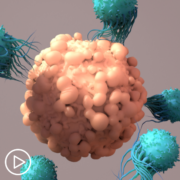Tools for Choosing Myeloma Therapy
Tools for Choosing Myeloma Therapy from Patient Empowerment Network on Vimeo.
When faced with choosing a myeloma treatment, what should be considered? This animated video reviews factors that impact treatment decisions, provides a list of questions to ask your healthcare team about therapy and advice for engaging in your myeloma care.
See More From Innovative Myeloma Therapies
Related Programs:

|

|
Transcript:
Whether a patient is newly diagnosed with myeloma or is facing a relapse, choosing a treatment approach can feel overwhelming.
Shared decision-making is a process where patients and healthcare providers communicate and collaborate to make care decisions. This approach encourages patients to take a more active role in their care and treatment and can help them feel more confident when choosing a therapy.
So, what can impact myeloma treatment decisions?
- There are patient-related factors, such as a patient’s age, fitness level, and pre-existing conditions.
- And, disease-related factors, including the aggressiveness of the patient’s disease and its location in the body.
- And, treatment-related factors, such as past treatments a patient has received or if they are refractory to medicines.
How can you play a role in making treatment decisions?
You can start by making a list of questions in advance of your appointment. This can help you to organize your thoughts before you meet with your healthcare team.
And, when working with your doctor to choose a treatment, consider asking the following questions:
- What type of myeloma do I have?
- Are there test results that may impact my treatment choices?
- What are the risks and benefits of each treatment option?
- What approach do you recommend and why?
- How is the treatment administered, and what side effects might I expect?
- What are my options if this treatment stops working?
- Are there newer treatment options available to me, including immunotherapy?
- And, is there a clinical trial that might be right for me?
It’s also a good idea to bring a friend or loved one to your appointment for support to take notes and help you recall information. Afterwards, discuss the appointment together – you can use this time to talk about your care plan and do your own research to learn more about your options.
The patient portal is another useful tool in your care. You can use it to view lab and test results. And you can use the messaging feature to communicate with your healthcare team when you have more urgent questions to address before your next visit.
Now that you know more about how to make myeloma treatment decisions, how can you take action?
- First, consider a second opinion or a consult with a specialist.
- Then, ensure you have had all relevant myeloma testing.
- Next, understand and participate in treatment decisions. This includes learning about your options, so you can weigh the pros and cons of each approach. And be sure to speak up and share your personal preferences and goals with your care team.
- Communicate regularly with your healthcare team – don’t wait to share information only when you have an appointment.
- And finally, bring a friend or loved one to appointments and always write down any questions or concerns in advance.
Visit powerfulpatients.org/myeloma to learn more about myeloma and access tools for self-advocacy.






